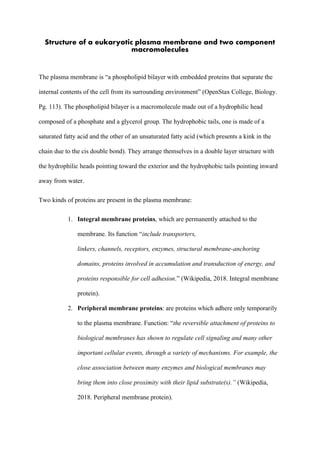Structure of a eukaryotic plasma membrane.pdf
•
0 gostou•109 visualizações
Description of the plasma membrane of a eukaryotic cell.
Denunciar
Compartilhar
Denunciar
Compartilhar
Baixar para ler offline

Recomendados
Recomendados
Mais conteúdo relacionado
Semelhante a Structure of a eukaryotic plasma membrane.pdf
Semelhante a Structure of a eukaryotic plasma membrane.pdf (20)
cell membrane transport mechanisms and related disorders ppt..pptx

cell membrane transport mechanisms and related disorders ppt..pptx
INTRODUCTION AND CELLULAR LEVEL OF ORGANIZATION.pptx

INTRODUCTION AND CELLULAR LEVEL OF ORGANIZATION.pptx
Último
Último (20)
TEST BANK For Radiologic Science for Technologists, 12th Edition by Stewart C...

TEST BANK For Radiologic Science for Technologists, 12th Edition by Stewart C...
Recombinant DNA technology (Immunological screening)

Recombinant DNA technology (Immunological screening)
Seismic Method Estimate velocity from seismic data.pptx

Seismic Method Estimate velocity from seismic data.pptx
VIRUSES structure and classification ppt by Dr.Prince C P

VIRUSES structure and classification ppt by Dr.Prince C P
Labelling Requirements and Label Claims for Dietary Supplements and Recommend...

Labelling Requirements and Label Claims for Dietary Supplements and Recommend...
Pests of mustard_Identification_Management_Dr.UPR.pdf

Pests of mustard_Identification_Management_Dr.UPR.pdf
Nightside clouds and disequilibrium chemistry on the hot Jupiter WASP-43b

Nightside clouds and disequilibrium chemistry on the hot Jupiter WASP-43b
Botany krishna series 2nd semester Only Mcq type questions

Botany krishna series 2nd semester Only Mcq type questions
Kochi ❤CALL GIRL 84099*07087 ❤CALL GIRLS IN Kochi ESCORT SERVICE❤CALL GIRL

Kochi ❤CALL GIRL 84099*07087 ❤CALL GIRLS IN Kochi ESCORT SERVICE❤CALL GIRL
9654467111 Call Girls In Raj Nagar Delhi Short 1500 Night 6000

9654467111 Call Girls In Raj Nagar Delhi Short 1500 Night 6000
Asymmetry in the atmosphere of the ultra-hot Jupiter WASP-76 b

Asymmetry in the atmosphere of the ultra-hot Jupiter WASP-76 b
Recombination DNA Technology (Nucleic Acid Hybridization )

Recombination DNA Technology (Nucleic Acid Hybridization )
Structure of a eukaryotic plasma membrane.pdf
- 1. Structure of a eukaryotic plasma membrane and two component macromolecules The plasma membrane is “a phospholipid bilayer with embedded proteins that separate the internal contents of the cell from its surrounding environment” (OpenStax College, Biology. Pg. 113). The phospholipid bilayer is a macromolecule made out of a hydrophilic head composed of a phosphate and a glycerol group. The hydrophobic tails, one is made of a saturated fatty acid and the other of an unsaturated fatty acid (which presents a kink in the chain due to the cis double bond). They arrange themselves in a double layer structure with the hydrophilic heads pointing toward the exterior and the hydrophobic tails pointing inward away from water. Two kinds of proteins are present in the plasma membrane: 1. Integral membrane proteins, which are permanently attached to the membrane. Its function “include transporters, linkers, channels, receptors, enzymes, structural membrane-anchoring domains, proteins involved in accumulation and transduction of energy, and proteins responsible for cell adhesion.” (Wikipedia, 2018. Integral membrane protein). 2. Peripheral membrane proteins: are proteins which adhere only temporarily to the plasma membrane. Function: “the reversible attachment of proteins to biological membranes has shown to regulate cell signaling and many other important cellular events, through a variety of mechanisms. For example, the close association between many enzymes and biological membranes may bring them into close proximity with their lipid substrate(s).” (Wikipedia, 2018. Peripheral membrane protein).
- 2. Membrane transport mechanisms: Transportation across the cell membrane is a very careful regulated mechanism. We could say in brief there are 4 ways of membrane transport: 1. Simple diffusion: it is the simplest way and consists in the pass of molecules that are small and non-polar. It does not require energy. 2. Facilitated diffusion: it is the pass of polar molecules and larger ions through the membrane by a membrane transport channel. An example is the transport of GLUT4 so important in diabetes. 3. In the primary active transport molecules move against their gradient coupled to the hydrolysis of ATP. This means (contrary to the two previous ways) that requires energy. An example of this is “the sodium-potassium pump (Na+/K+ ATPase) that helps maintain resting potential in the cell. This protein uses the energy released from hydrolysis of ATP (adenosine triphosphate) to pump three sodium ions out of and two potassium ions into the cell.” (Khan Academy. Passive transport and active transport across a cell membrane article). 4. Secondary active transport “moves multiple molecules across the membrane, powering the uphill movement of one molecule(s) (A) with the downhill movement of the other(s) (B). For example, SGLT2 is a glucose transporter that allows glucose (Molecule A) into our cells (against its gradient) by bringing in a sodium molecule (Molecule B) as well.” (Khan Academy).
- 3. Endocytosis and Exocytosis: This occur for bulk transport. There are two forms of endocytosis, one is phagocytosis, where the cell engulfs a solid (a bacteria for instance) and wraps it around with cell membrane forming a food vacuole. When the cell captures a liquid doing the same mechanism as the phagocytosis but in this case englobing a liquid substance, we call it pinocytosis. Exocytosis is a form of active transport in which the cell transports large molecules out of the cell. An example of this is the release of proteins outside of the cell to be used for certain functions. Another example is found in neurons that form synaptic vesicles to release neurotransmitters. RESOURCES: 1. Khan Academy. Passive Transport and Active transport Across the Cell Membrane. Retrieved from: https://www.khanacademy.org/test-prep/mcat/cells/transport-across- a-cell-membrane/a/passive-transport-and-active-transport-across-a-cell-membrane- article 2. OpenStax College, (May 30, 2013). Biology. OpenStax College. http://cnx.org/content/col11448/latest 3. University of Washington. Membrane Transport Mechanisms. Retrieved from: https://courses.washington.edu/conj/bess/transport/summary/membrane- transport.html 4. Wikipedia. (2018). Integral Membrane Protein. Retrieved from: https://en.wikipedia.org/wiki/Integral_membrane_protein